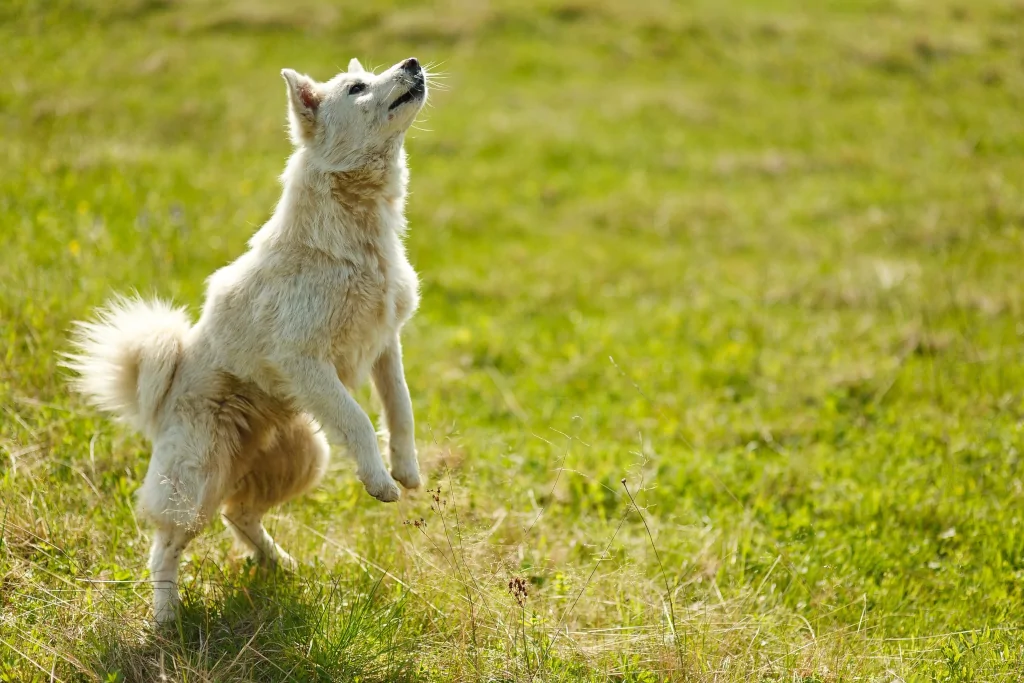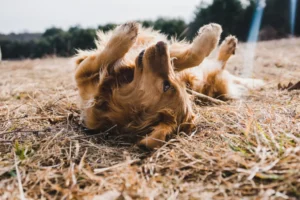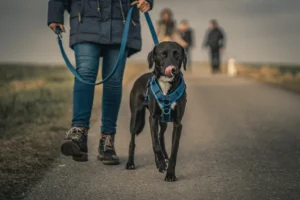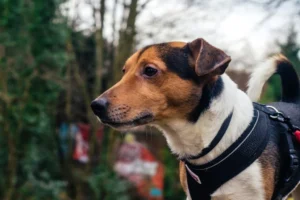Are you struggling to find new ways to engage with your furry friend and improve their obedience? Tired of the same old fetch and walks routine?
Don’t worry, we’ve got your back. I remember teaching my dog Sam his first trick, the classic “sit,” and seeing that sparkle in his eyes as he proudly accomplished it. It was a game-changer for our relationship, and it can be for yours too!
Related trick-training guides:
Roll Over
Play Dead
Spin or Twirl
Shake or Paw
High Five
Bow
Fetch

What is Trick Training and Why is it Important?
Trick training is the process of teaching your dog a variety of tricks or commands, which can range from simple cues like “shake” to more complex feats such as rolling over or playing dead.
Building upon basic obedience skills, trick training offers a fun, interactive way for you and your dog to bond, while promoting good behavior, boosting your dog’s mental health, and improving their overall obedience.
By introducing trick training into your daily routine, you’ll be paving the way for a happier, healthier, and more well-behaved canine companion.
Your dog can also help out by performing various simple tasks, such opening doors, turning off lights, or carrying items.
So, let’s dive in and explore the wonderful world of trick training!
How Does Trick Training Enhance Bonding?
Trick training is a fantastic way to strengthen the bond between you and your dog. It encourages trust, cooperation, and communication, which are essential ingredients for a strong relationship.
During trick training, you spend quality time together, focusing on each other and working as a team.
I’ll never forget the time I taught Sam how to “spin” in a circle. We had so much fun, and his wagging tail and excited barks showed me just how much he enjoyed our sessions. The sense of accomplishment you both feel when your dog masters a new trick is priceless and creates a deep connection that lasts a lifetime.
How Trick Training Benefits Your Dog’s Mental Health
Trick training isn’t just about bonding, but it’s also a great way to support your dog’s mental health.
Like humans, dogs need mental stimulation to stay happy and healthy. Engaging in trick training challenges your dog’s brain, keeping them mentally sharp and warding off boredom-related issues like destructive behavior or excessive barking.
When I taught Sam the “hide and seek” trick, I could see his problem-solving skills and focus improving. As he searched for a hidden treat, his determination and concentration grew, and the excitement of finding the reward was incredibly satisfying for him.
Not only did this help keep his mind sharp, but it also provided an outlet for his energy and curiosity, ensuring a happier and more content dog.
So, trick training is not just entertaining – it’s essential for your dog’s mental wellbeing too!
Easy Tricks for Beginners: Where to Start?
When beginning trick training with your dog, it’s important to start with simple tricks that build a solid foundation for more advanced tricks later on. Let’s explore some easy-to-learn tricks and tips to set you and your dog up for success.
Teaching “Sit”
“Sit” is a basic command and the perfect starting point for trick training. To teach your dog to sit, hold a treat close to their nose and slowly lift it above their head. As your dog’s gaze follows the treat, their bottom should naturally touch the ground. When this happens, say “sit” and reward them with the treat and praise.
We have an easy-to-follow guide on the “Sit” command, with some common obstacles and solutions to overcome. Check it out to teach your dog to sit easily!
When I taught Sam the “sit” command, I made sure to practice in various locations to help him generalize the behavior. Consistent practice will help your dog master this essential command in no time.
Mastering “Shake” or “Paw”
Once your dog has learned to sit, you can teach them the “shake” or “paw” trick.
For a full guide, go here, but here’s a shorter version: Ask your dog to sit and then present your hand with your palm facing up. Gently tap your dog’s paw, and when they lift it, say “shake” or “paw” and give them a treat. Repeat this process until they can perform the trick without physical prompting.
Introducing “Lie Down”
“Lie down” or “Down” is another fundamental command. To teach it, ask your dog to sit first. Hold a treat near their nose and slowly move it toward the ground. As your dog follows the treat, their body should lower into a lying position. When this happens, say “lie down” and reward them with the treat and praise.
A simple step-by-step guide on the “Down” command is also available, and we encourage you to check it out. It’s not long, and it includes some common challenges as well, so you can easily overcome common issues with your dog.
I remember when I first taught Sam to “lie down,” he was hesitant to lower himself completely to the ground. With patience and positive reinforcement, he eventually became confident and would lie down on command without hesitation.
Remember, trick training should always be a fun and positive experience for both you and your dog.
Keep sessions short and upbeat to maintain their interest and motivation. As you progress, you can gradually introduce more complex tricks, such as “roll over“, “play dead“, and “spin” building on the foundation of these beginner commands.
Training Methods and Tools: What Works Best?
When it comes to trick training, there’s no one-size-fits-all approach. The key is to find what works best for you and your dog. Let’s explore some popular training methods and tools to help you get started.
Positive Reinforcement
Positive reinforcement is a widely used and highly effective training method that focuses on rewarding good behavior.
This approach builds trust, strengthens your bond with your dog, and encourages them to repeat the desired behavior. Treats, toys, and praise are all great rewards to use during trick training sessions.
Read more: How to Pick Perfect Training Toys for Your Dog
I’ll never forget how Sam’s eyes lit up whenever he received a treat for performing a trick correctly. Positive reinforcement not only helped him learn faster but also made the process enjoyable for both of us.
Clicker Training
Clicker training is a form of positive reinforcement that uses a small device that makes a clicking sound to mark the exact moment your dog performs the desired behavior.
The clicker is followed by a reward, creating a clear association between the action and the positive reinforcement. This method allows for precise communication, making it easier for your dog to understand what’s expected of them.
Lure-and-Reward Training
Lure-and-reward training involves using a treat or toy to guide your dog into the desired position or behavior.
Once the dog performs the action, they’re rewarded with a treat or toy. This method can be particularly effective for teaching tricks that involve specific body movements or positions, such as “sit” and “lie down.”
Target Training
In target training, your dog is taught to touch an object, such as a target stick, with a specific body part, like their nose or paw. This technique can be used to teach more advanced tricks or to guide your dog through a series of actions.
For example, target training can be used to teach your dog to spin in a circle or weave through your legs.
When I introduced target training to Sam, I used a target stick to guide him through a series of cones. He quickly caught on and seemed to enjoy the mental challenge.
Remember, the most effective training method for your dog will depend on their individual temperament, learning style, and your own preferences. Be patient, and consistent, and don’t be afraid to switch methods if something isn’t working. The key is to create a positive, engaging, and rewarding experience for both you and your dog.
How Trick Training Improves Overall Obedience
Trick training does more than just entertain – it can significantly improve your dog’s overall obedience.
By teaching your dog new tricks, you’re reinforcing the idea of following your commands, which in turn helps establish a strong leadership role in your dog’s life.
Additionally, trick training improves communication between you and your dog, making it easier for them to understand your expectations.
When I taught Sam to “play dead,” I noticed that not only did he master the trick quickly, but he also started responding better to other basic commands like “sit” and “stay.” The consistent practice and reward system helped reinforce his obedience in all areas.
Making Trick Training Fun and Engaging
To make trick training fun and engaging, it’s essential to keep sessions short, positive, and varied. Try incorporating different tricks, such as high-fives, rolling over, or even fetching specific items.
Make it a game by hiding treats and teaching your dog to find them, or play “hide and seek” with your dog by having them stay while you hide, then calling them to come find you.
Sam and I loved playing “hide and seek” together. I’d hide behind a tree, and when I called him, he’d excitedly search for me, his tail wagging non-stop. It was not only a great bonding experience, but also a fun way to practice his recall skills.
Trick training is a fundamental part of training dogs for performances, such as in circuses. Learn more about this in our blog post about circus dog breeds.
Here are 20 dog trick to learn from Kikopup:
FAQs
How much time should I allocate for trick training each day?
Aim for two or three short sessions of 5-10 minutes each day to keep your dog engaged and prevent burnout.
Can I teach multiple tricks at once?
Yes, you can teach multiple tricks at once, but it’s best to focus on one trick per session to avoid confusion.
Are there any age limits for trick training?
There are no specific age limits for trick training, as dogs of all ages can learn new tricks. However, it’s generally easier to train young puppies, and older dogs may require more patience and repetition.
Can trick training help with aggression issues?
Trick training can help with aggression issues by redirecting your dog’s energy and focus, building trust, and improving communication. However, for severe aggression issues, it’s essential to consult with a professional dog trainer or behaviorist.
Alex, a passionate animal lover, has experience in training and understanding animal behavior. As a proud pet parent to two dogs and three cats, he founded AnimalReport.net to share insights from animal experts and expand his knowledge of the animal kingdom.









